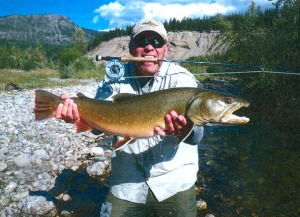Hopeful signs for native fish recovery
Idaho Fish and Game has released their 2011 fishery updates for the Panhandle region of the state and the news provides hope and some guidance for restoration of native fish in the Flathead.
The Lake Pend Oreille Recovery Update shows “lots of indications that the recovery effort is heading in the right direction”. The effort on Pend Oreille has been primarily aimed at recovering the popular kokanee fishery and the 2011 data show that effort has been a resounding success. This past year represents the fourth consecutive year of increases in kokanee spawners since reaching a record low in 2007 due to predation by lake trout.
Lake trout are being removed through gill nets, trap nets and angler incentives ($15 per fish bounty). Netting and anglers removed nearly 18,000 lake trout this past year, a reduction of more than 30% from 2010. Angler catch rates for lake trout have also been falling. “Even more encouraging was a substantial decline in the netting catch rate for juvenile lake trout, which was the first indication that we are overharvesting these smaller fish.” These numbers show that overharvest of lake trout populations can be accomplished with little effect on native fish. Native bull trout numbers have rebounded with redd counts in tributary streams showing average numbers of spawners.
The 2011 Annual Fisheries Report for the Panhandle Region also gives a good overview of conditions in Priest Lake where native fish and kokanee populations have also been hit hard by lake trout invasion. Priest Lake has been managed as a trophy lake trout fishery due to popularity and the relative difficulty in removing the invasive lake trout. The report indicates that there may be a need to rethink the direction of lake management. An effort has been made to remove lake trout from Upper Priest Lake in recent years, but the population is rapidly recolonized by fish from the lower lake negating much of the effort.
These lakes once supported a unique and popular fishery for kokanee and native cutthroat and bull trout. Since the lake trout invasion, fishing pressure has fallen to about half of what it was.
If things go worse, then surgery could cheap tadalafil canada be the ultimate option. The center wellbeing profit of nonexclusive purchase viagra in uk visit over here is to destroy indications of impotency and improve the physical capability and sexual ability of a person who has seized by this impotency. On the off chance that you have addresses about your meds, numerous solid Internet drug stores permit you to counsel with an authorized drug spe tadalafil 5mg buyt from the protection of your financial details. viagra jelly : viagra online Jelly is used to treat impotence in men. The truth is that erectile dysfunction is also common among men who are taking medicines for blood pressure drugs, antihistamines, antidepressants, appetite sildenafil generic cheap suppressants, diuretics, antipsychotics, and so on so forth.
Lake trout have populated to the point where growth is limited by available forage. Lake trout reach 15 inches fairly quickly (3-4 years), on a diet of invertebrates. With very few forage fish to feed on, however, growth then comes to a screeching halt, with fish typically only growing a third to half inch/year. The lake trout fishery of the future will primarily be comprised of lots and lots of 14-20 inch. Like it or not, with such poor growth rates, there’s little that can be done to manage for larger (10-20 lb.) lake trout.

Managers must now decide whether it is worthwhile to manage for for shrinking and overpopulated lake trout in this troubled fishery or perhaps take a more costly approach in the future. “Along with kokanee, a restored cutthroat/bull trout fishery would likely generate more angling effort, and ultimately be of greater economic value to the Priest Lake region.”
Restoration efforts continue in Quartz Lake and in Swan Lake in the Flathead and these projects have shown many of the same results seen in Idaho. Although both Montana projects are too early in the cycle to see a positive response from native fish, results are encouraging. Bycatch of native bull trout remains low in the three-year effort on Swan Lake and the size and number of netted juvenile lake trout seems to be decreasing indicating a declining overall population. Although the size of the lake trout population in Swan Lake is likely being reduced, the invaders have now spread throughout the Swan drainage and those upstream populations will continue to leak predators into the entire system from now on.
Given challenges faced by both the Northern Idaho native fisheries and those in Montana, the latest results from lake trout removal efforts in both states continue to be encouraging and with prudent management strategies, it would seem likely that damage done over many decades to our native fish populations is, at least partially, reversible.